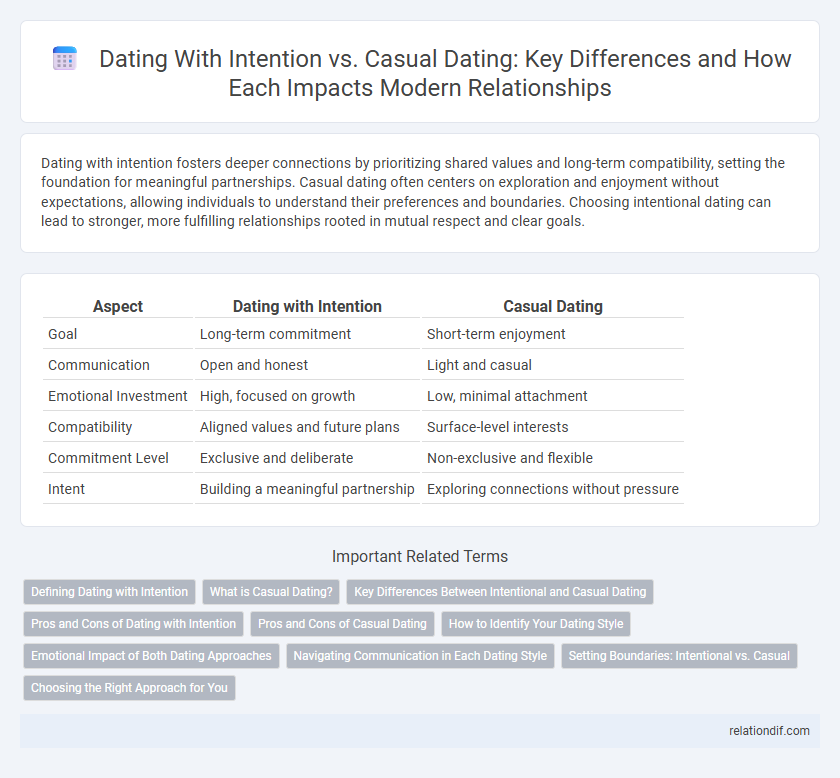Dating with intention fosters deeper connections by prioritizing shared values and long-term compatibility, setting the foundation for meaningful partnerships. Casual dating often centers on exploration and enjoyment without expectations, allowing individuals to understand their preferences and boundaries. Choosing intentional dating can lead to stronger, more fulfilling relationships rooted in mutual respect and clear goals.
Table of Comparison
| Aspect | Dating with Intention | Casual Dating |
|---|---|---|
| Goal | Long-term commitment | Short-term enjoyment |
| Communication | Open and honest | Light and casual |
| Emotional Investment | High, focused on growth | Low, minimal attachment |
| Compatibility | Aligned values and future plans | Surface-level interests |
| Commitment Level | Exclusive and deliberate | Non-exclusive and flexible |
| Intent | Building a meaningful partnership | Exploring connections without pressure |
Defining Dating with Intention
Dating with intention centers on building meaningful connections aligned with personal values and long-term goals, contrasting casual dating's emphasis on short-term enjoyment without expectations. It involves clear communication about relationship desires, fostering trust and emotional depth. This approach supports purposeful partner selection, enhancing compatibility and relationship satisfaction.
What is Casual Dating?
Casual dating involves engaging in romantic or social interactions without the expectation of a long-term commitment or exclusive partnership. It emphasizes flexibility, enjoyment, and exploration without the pressures of defining the relationship. This approach allows individuals to meet diverse people, prioritize personal growth, and maintain independence while experiencing varied connections.
Key Differences Between Intentional and Casual Dating
Intentional dating prioritizes building meaningful connections centered on long-term compatibility, shared values, and clear relationship goals, whereas casual dating emphasizes flexibility, exploration, and enjoyment without immediate commitment. Individuals practicing intentional dating engage in open communication, mutual respect, and deliberate decision-making to nurture emotional intimacy. In contrast, casual dating often involves less emotional investment and more focus on socializing or physical attraction without expectations for future togetherness.
Pros and Cons of Dating with Intention
Dating with intention fosters deeper emotional connection and clearer communication, increasing the likelihood of long-term compatibility and shared goals. It demands commitment and vulnerability, which can be challenging but ultimately leads to more meaningful relationships and reduces uncertainty. However, it may limit social opportunities and require more time investment compared to casual dating, where flexibility and exploration are prioritized.
Pros and Cons of Casual Dating
Casual dating offers flexibility and low pressure, allowing individuals to explore multiple connections without commitment, which can be ideal for personal growth and social variety. However, it may also lead to emotional ambiguity, misaligned expectations, and challenges in developing deeper intimacy. Understanding these pros and cons helps individuals make informed choices aligned with their relationship goals.
How to Identify Your Dating Style
Identifying your dating style begins with recognizing your core relationship goals, whether seeking meaningful connection or casual companionship. Reflect on past experiences and emotional responses to differentiate intentional dating, characterized by clear communication and long-term focus, from casual dating, which emphasizes flexibility and low commitment. Understanding these patterns helps tailor your dating approach to align with personal values and desired partnership outcomes.
Emotional Impact of Both Dating Approaches
Dating with intention fosters deeper emotional connections by prioritizing meaningful communication and shared goals, which often leads to greater relationship satisfaction and stability. Casual dating frequently results in short-term emotional highs but can also cause feelings of uncertainty and detachment due to a lack of commitment. Understanding the emotional impact of both approaches helps individuals choose paths aligned with their personal values and emotional well-being.
Navigating Communication in Each Dating Style
Navigating communication in dating with intention involves clear, honest dialogues centered on long-term goals and emotional compatibility, fostering deeper connections. In contrast, casual dating emphasizes open, flexible communication to set boundaries and manage expectations without pressure for future commitment. Understanding these distinct communication dynamics is crucial for aligning partner intentions and maintaining respect within each dating style.
Setting Boundaries: Intentional vs. Casual
Setting boundaries in intentional dating involves clear communication of values, long-term goals, and emotional limits to foster trust and mutual respect. Casual dating typically features more flexible boundaries, prioritizing fun and exploration without deep commitments or expectations. Establishing these different boundary frameworks directly impacts relationship dynamics and emotional well-being.
Choosing the Right Approach for You
Choosing the right dating approach depends on personal goals and emotional readiness, with dating with intention prioritizing meaningful connections and long-term commitment. Casual dating offers flexibility and exploration without immediate expectations, ideal for those focused on self-discovery. Assessing your values and relationship objectives helps determine whether intentional dating or casual experiences align best with your partnership aspirations.
dating with intention vs casual dating Infographic

 relationdif.com
relationdif.com